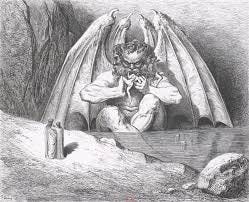In this Kaliyuga, There is no concrete concept of ‘good’ and ‘evil’. Unfortunately, kind people get continually used and exploited until they become what they seek to destroy — evil.
This post dives deep into the depths of the human mind, and how certain circumstances can turn them into absolute animals when imposed on a well-mannered, civilized group of people.

The ‘Lucifer’ Effect — is basically, the phenomenon through which people tend to do the unthinkable when it is not expected of them. This effect is the precursor of almost every unsolved demon possession case, that has occurred in the history of catholic/orthodox Christianity. (It’s like the roots of a quadratic equation, now it may be real or imaginary…the difference defines if it is explainable or not)
The Stanford Prison Experiment
The famous Stanford Experiment conducted in 1971 in the basement of Stanford University’s basement building gave some serious insights into how “power” and “social roles” can affect the behaviour of people.
The Basement was turned into a simulated prison with students becoming “prison guards” with equipped batons and all the necessities real prison guards should have.
Some of the other students were turned into prisoners, with their names being switched with numbers and orange uniforms
the main duration for the experiment to take place was 2 weeks, and it would be used to study human psychology in a greater depth
These were the main aims, objectives, and goals for this experiment. Now, guess in how many days the experiment had to be forcefully shutdown?
6 days…
Yes, it took only 6 days for the situation to escalate so much, that the prisoners were getting mentally and physically tortured by the “prison guards”. The participants forgot that it was only an experiment meant to simulate a real prison and to help study human psychology
some “prisoners” had to undergo real mental therapy and consultation sessions to come out of the trauma they experienced, in just a matter of days!
How does The Lucifer Effect explain this horror?
The Lucifer Effect suggests why such escalation happened…
Role-playing: The participants were assigned the role of "guard" and given uniforms, batons, and mirrored sunglasses, symbolizing power and authority. This deindividuation and immersion in the guard role led them to adopt behaviors they might not otherwise exhibit.
Power Imbalance: The guards were given almost complete control over the prisoners, with the ability to create and enforce rules. This power dynamic quickly led to abuse, as some guards relished their newfound authority and used it to humiliate and degrade the prisoners.
Lack of Accountability: The guards were not explicitly told they could not physically harm the prisoners, and Zimbardo himself, acting as the "warden," created an environment where abusive behavior was implicitly condoned. This lack of clear boundaries and oversight contributed to the escalation of abuse. (P.S Zimbardo first coined the term, ‘The Lucifer Effect’)
Deindividuation: The uniforms and mirrored sunglasses worn by the guards created a sense of anonymity, making it easier for them to engage in behaviors they might normally avoid. This deindividuation also contributed to a loss of personal responsibility, as the guards felt they were acting as part of a group rather than as individuals.
Situational Norms: The environment of the simulated prison, with its oppressive atmosphere and lack of privacy, created a sense of unease and tension. The guards may have felt pressure to conform to the perceived norms of the situation, leading them to act in ways they might not have otherwise.
Point No.4, can also be explained by another phenomenon known as The Bystander Effect ( basically, the chances of a random person helping a victim of an accident, are less likely if other people are present to help the victim too.)
The Bystander Effect, fueled by Deindividuation becomes the first catalyst to help people turn to evil. Because then they lose the accountability, and responsibility of upholding social order.
This therefore explains the abusiveness and torture that started to unfold in the basement of Stanford. But why did the prisoners not revolt? It was not a real prison…or is it?
The main two phenomena that can explain such behavior are — Learned Helplessness and Liminality
In the context of the Stanford Prison Experiment, liminality explains the psychological and social transformations participants experienced as they were placed in a transitional, undefined state between their real-world identities and the artificial roles of "prisoner" or "guard." This transitional phase created an environment of disorientation, compliance, and role absorption.
Liminality was the first thing that occurred in the experiment, and that led to the development of ‘Learned Helplessness’
Learned helplessness is a psychological phenomenon where individuals develop a passive and resigned attitude after experiencing repeated negative events that they feel powerless to control or avoid. Over time, they stop attempting to change their situation, even when opportunities to escape or improve arise.
So what can we conclude from this entry?
People who have never felt power in their life will abuse it almost every single time the moment they achieve it. This behavior can be explained using The “Abilene Paradox” which is like a sister to “The Lucifer Effect”
People will go to any extent to establish a hierarchy in a social group, however vile or cruel it may be. This can be explained using “The Social Comparison Theory”, where people tend to evaluate themselves by comparing.
People will do anything possible, once the “responsibility” is out. People hate to answer themselves and reason with others, when they have what is known as a “ coercive advantage ”. This behavior is explained by Social Dominance Orientation ( SDO), a fancy sub-type of Machiavellianism.
if you remove “responsibility”, “reason” and “reputation” from a person, and add “Power”, “Deindividuation”, and “Coercive Dominion”, you get “Evil”.
Evil might sound like an abstract term, but it is tangible as in flesh and blood around us everywhere. People committing heinous crimes and regretting nothing, inflicting pain for personal gain, and destroying lives and livelihoods are a very small fraction of the Real “Evil” that lurks in the world
I would like to end this entry, with a famous quote ( which I do not know who quoted, to be honest)
The greatest evil is the evil that fails to recognize its evil…
Har Har Mahadev…
Subscribe to my Newsletter if you are new…it’s free and you will get to know new stuff for free, directly delivered to your mailbox!





